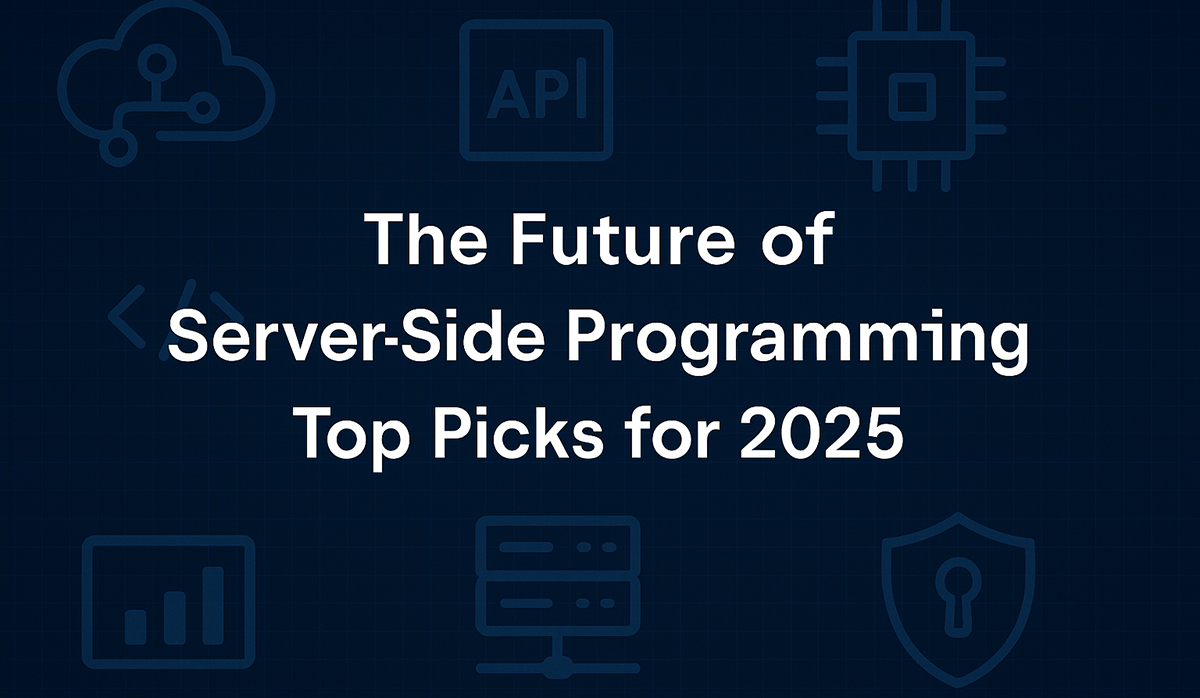No products in the cart.
 Server-Side Showdown: Best Programming Languages for 2025
Server-Side Showdown: Best Programming Languages for 2025
The server-side landscape in 2025 is evolving rapidly. Businesses are now choosing backend technologies that go beyond just performance they must ensure scalability, rapid deployment, and top-tier cybersecurity. Selecting the right coding language is critical for building secure, scalable, and high-performance server applications in 2025.
The Role of Language in Scalable and Stable Backend Systems
For server-side development, programming language decisions have a direct impact on application stability, backend performance under load, and how easily you can integrate with modern infrastructures like containers, edge networks, and serverless frameworks.
Key Criteria for Server-Side Language Selection in 2025
As we look deeper into backend infrastructure requirements in 2025, it’s clear that developers, DevOps engineers, and infrastructure architects are prioritizing server-side development languages that support high concurrency, secure memory management, and seamless cloud integration.
Best Languages for Kubernetes and Docker-Based Infrastructure
Businesses moving toward containerized infrastructure using Docker and Kubernetes prefer lightweight, statically compiled languages. This is where Go and Rust stand out as top backend coding languages for containerized server deployments in 2025. They start faster, consume fewer resources, and deliver rock-solid performance in clustered environments.
High-Performance Languages Powering Modern Backends
Go is being chosen by cloud-native teams looking to build ultra-fast microservices. Its speed, simplicity, and concurrency model make it a top option for those aiming to build high-performance backend servers with low latency in 2025. This makes it a strong choice for anyone building distributed systems or real-time apps at scale.
Rust: The Secure Backbone of Modern Server-Side Development
Rust is rapidly gaining traction for server-side programming due to its memory safety and unmatched control. Developers are increasingly using Rust for secure server-side applications with zero memory leaks and high concurrency. It’s especially favored in fintech, cybersecurity, and any use case where server-side logic must be rock-solid.
Real-Time Performance with Node.js Backends
Companies that rely on event streaming, WebSocket communication, and real-time sync are scaling with Node.js backends optimized for live collaboration apps and real-time dashboards. JavaScript’s ubiquity on both frontend and backend makes it easier for teams to ship fast and maintain clean codebases across platforms.
Node.js, powered by JavaScript and often TypeScript, is being widely adopted in 2025 for applications that require real-time data exchange. Businesses are selecting Node.js for developing real-time server-side applications with low response times and event-driven architecture. Its asynchronous model ensures non-blocking performance, even at scale.
When it comes to rapid backend development for AI-powered platforms, Python continues to shine. Its ability to integrate with machine learning models and data processing libraries gives it a dominant role in building server-side APIs for ML workflows and intelligent automation. As of 2025, FastAPI, Flask, and Django maintain their status as the most widely adopted Python-based server-side frameworks.
Java, with its Spring Boot ecosystem, is still the go-to for regulated industries. For high-compliance and cloud-native backend systems, enterprises in 2025 predominantly rely on Java as their preferred development language. Its stability, support, and cloud integration make it ideal for critical applications.
In both Windows and hybrid cloud environments, C# and .NET remain widely adopted and influential development frameworks. C# and .NET continue to serve as foundational platforms for development within Windows and hybrid cloud infrastructures. maturing, developers are using C# for cross-platform backend development for enterprise-grade cloud services. Its tight Azure integration and performance enhancements make it viable across industries.
Developers building for hybrid clouds or edge networks are choosing languages that support modular, distributed deployment. Modern server-side development demands languages with multi-threading capabilities, RESTful and GraphQL API integration, and DevSecOps-friendly toolchains.
Why Go, Rust, and .NET Core Are Leading Server-Side Evolution
Meanwhile, cloud service providers like AWS, Azure, and Google Cloud are continuing to support a diverse set of runtimes, but optimization is key. There is a strong correlation between the efficiency of the development language and both backend system performance and operational overhead. Many teams are switching from interpreted languages to compiled ones to reduce cold start times and optimize CPU usage in serverless deployments. That’s why languages like Go, Rust, and .NET Core are seeing a sharp rise in adoption for high-load server functions in 2025.
Security threats are evolving, too. With the rise of ransomware and API attacks, organizations are shifting toward secure-by-design server-side languages that reduce the attack surface. Rust, in particular, is leading this space with memory safety as a language feature not just a runtime add-on. It’s becoming the default for organizations investing in high-assurance server codebases and secure infrastructure pipelines.
At actsupport.com, we work with all these technologies to deliver managed server environments, cloud migrations, and high-performance backends tailored to business needs. Our expertise helps you build and maintain secure and scalable backend infrastructure using modern programming languages in 2025.
Whether you’re deploying microservices, hardening Linux servers, or building backend platforms for SaaS, fintech, or AI apps the right language sets the tone for long-term success.
To succeed in 2025, your backend codebase must be secure by default, optimized for performance, and ready for cloud-native scaling. actsupport helps you get there faster.
Stay updated! Follow us on social media! Facebook, Twitter, LinkedIn
Check out our newest blog entry (AWS, Azure, or Google Cloud: Who’s Leading in 2025?)



 Server-Side Showdown: Best Programming Languages for 2025
Server-Side Showdown: Best Programming Languages for 2025